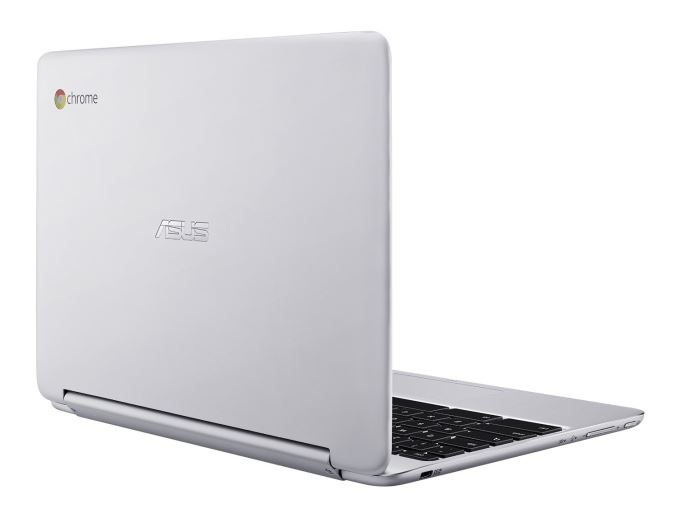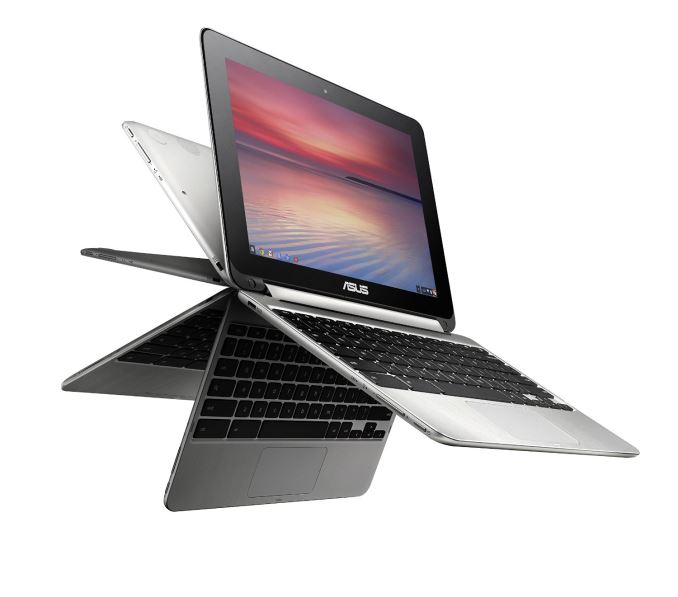ASUS Releases Convertible ChromeBook Flip C100
by Brett Howse on July 20, 2015 6:15 PM EST- Posted in
- Chromebook
- Asus

Today ASUS is launching a new Chromebook, but this one gets the flip treatment with a 360° hinge. According to ASUS, it brings together the experiences of a tablet and notebook into one device. We’ve certainly seen a lot of these on the Windows side, but for a device packing Chrome OS, this is certainly less common if not unique.
Let’s go over what is inside. ASUS turned to Rockchip for the processor on this device with the Rockchip 3288-C SoC inside. This is a quad-core design based on the Cortex A17, and clocks in at 1.8 GHz. The GPU is the ARM Mail T624, and you can get either 2 or 4 GB of system memory and 16 GB of eMMC storage. It also supports a SD/SDXC card reader if you need to add a bit more storage.
Although the internals are certainly low end, ASUS did put a multi-touch IPS display in, albeit at only 1280x800 resolution, but for the 10.1” low cost device, that is likely serviceable. There are also outputs for HDMI if necessary and of course a headset jack. There are two USB 2.0 ports for connectivity, and the battery is rated for up to nine hours.
| ASUS ChromeBook Flip C100 | |
| Processor | Rockchip 3288-C Quad-core Cortex A17 @ 1.8 GHz ARM Mali T624 GPU |
| Connectivity | 802.11ac Bluetooth 4.1 |
| Memory | 2G or 4GB DDR3L |
| Storage | 16GB eMMC |
| Battery | 2-cell up to 9 hours |
| I/O | 2 x USB 2.0 HD webcam micro HDMI Headphone/mic jack SD Card reader |
| Dimensions | 10.35" x 7.18" x 0.6" / 263 x 182 x 15.2 mm |
| Display | 10.1" 1280x800 IPS LCD with capacitive touch |
| Weight | 1.96 lbs / 0.89 kg |
| Price | $249/$299 for 2GB/4GB |
The keyboard is 97% of a full-sized notebook keyboard, so despite the small size it should be reasonable to type on.
Speaking of size, the 0.6-inch body weighs in at just under two pounds, so it should be easy to tote around. That’s nothing like what an actual tablet weighs of course, but for a small notebook it is very light.
My biggest concern with the ChromeBook Flip C100 is the operating system though. Windows devices have been sporting these convertible designs for some time, but Windows 8 was built with touch as a primary input device, and although the Windows store is not as fleshed out as the iOS tablet store, it is certainly more fleshed out that Chrome OS as a tablet OS.
If you are interested in kicking the tires on one of these, they are available now from the ASUS eStore, Newegg.com, and Amazon.com for $249 (2GB) or $299 (4GB).
Source: ASUS

















46 Comments
View All Comments
nandnandnand - Monday, July 20, 2015 - link
Looked up DDR3L 8 GB on Newegg. Roughly $43-50. So if the RAM is user-replaceable you can get the 2 GB version, upgrade to 8 GB for about the same price as the 4 GB version, and chuck the 2 GB stick at a street urchin.ImSpartacus - Monday, July 20, 2015 - link
How's Asus' track record for this sort of thing.Impulses - Tuesday, July 21, 2015 - link
For what sorta things? They started off amazingly well in the Android tablet space, the OG Transformer was slightly cheaper than others and better built (tho that's not saying much when compared to Acer and Moto's Xoom, still...), and the Nexus 7 was obviously huge... They were doing pretty great with updates early on too, I think they lost the plot later in launching way too many devices (one slight TF iteration after the other, etc).The MemoPad line has been a strong value tho and the just released Zen S 8" seems to bring back the value punch to the market that'd been missing since the N7 stopped selling officially at the Play store (at least I haven't seen anything better for $200, and everything else decent is $300 or also out of production).
Sooo, mixed but positive overall? I think they seem to do a lot better when they try to undercut the Samsungs and Apples than when they try to go all out.
ant6n - Tuesday, July 21, 2015 - link
on an ARM chromebook? doubtfulzodiacfml - Tuesday, July 21, 2015 - link
Too thin and cheap for it to have a user replaceable RAM. More likely, soldered.damianrobertjones - Tuesday, July 21, 2015 - link
For the extra cash you could just buy a windows machine and then upgrade whatever (Within reason).coolbho3k - Tuesday, July 21, 2015 - link
That's a 32-bit SoC...Flunk - Tuesday, July 21, 2015 - link
It's a SoC, the RAM is almost assuredly soldered on top of the SoC.extide - Tuesday, July 21, 2015 - link
Probably not, PoP is a bit more expensive, and the main benefit of doing it is reduced PCB area requirements, so I bet it is not PoP. However, it is probably soldered on, just not on top of the SoC ;)jjj - Monday, July 20, 2015 - link
Is there an app issue when the point is no apps? Sure more recently that has been relaxed and some Android apps migrated to it but those are built for touch and this opens the door for more.So maybe if you don't forget what it is and why buyers want it, there is no issue. If it makes sense to add the tablet mode as a bonus, not sure , maybe it makes as much sense as ChromeOS laptops did some years ago. I'm not much of a fan of what they did here , just not convinced the app problem is a problem. I don't own a Chromebook so not easy to imagine what users want but we shouldn't compare it with very different OSes, something that non-users always forget.